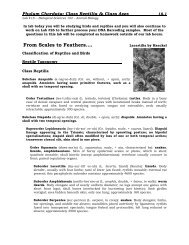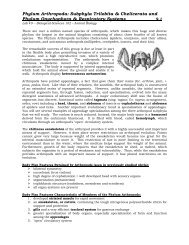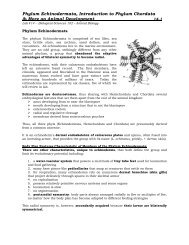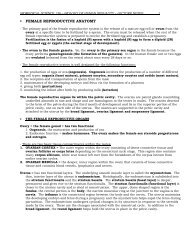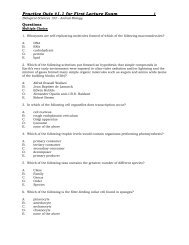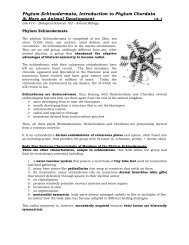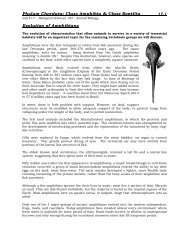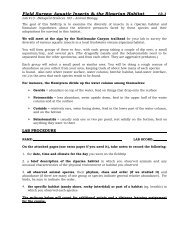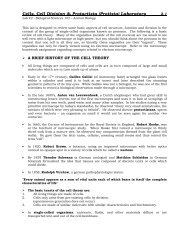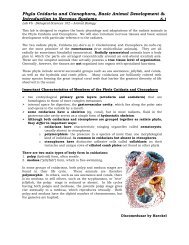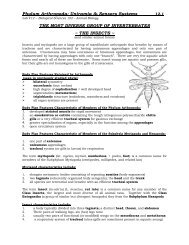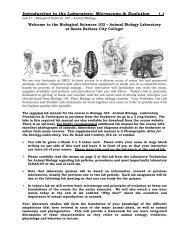Phyla Cnidaria and Ctenophora, Basic Animal ... - Biosciweb.net
Phyla Cnidaria and Ctenophora, Basic Animal ... - Biosciweb.net
Phyla Cnidaria and Ctenophora, Basic Animal ... - Biosciweb.net
- No tags were found...
Create successful ePaper yourself
Turn your PDF publications into a flip-book with our unique Google optimized e-Paper software.
<strong>Phyla</strong> <strong>Cnidaria</strong> <strong>and</strong> <strong>Ctenophora</strong>, <strong>Basic</strong> <strong>Animal</strong> Development &Introduction to Nervous Systems 5.2Lab #5 - Biological Sciences 102 – <strong>Animal</strong> BiologyClassification of the Radiate <strong>Animal</strong>sPhylum <strong>Cnidaria</strong>Class Hydrozoa (hy-dro-zo'a) (Gr. hydra, water serpent, + zoon, animal).Both polyp <strong>and</strong> medusa stages represented, although one type may besuppressed; medusa with a velum; found in fresh <strong>and</strong> marine water. Thehydroids. Examples: Hydra, Obelia, Gonionemus, Tubularia, PhysaliaHydraClass Scyphozoa (sy-fo-zo'a) (Gr. skyphos, cup, + zoon, animal). Solitary; medusa stage emphasized;polyp reduced or absent; enlarged mesoglea; medusa without a velum. The true jellyfish. Examples:Aurelia, Rhizostoma, CassiopeiaClass Cubozoa (ku'bo-zo'a) (Gr. kybos, a cube, + zoon, animal). Solitary; polyp stage reduced; bellshapedmedusae square in cross section, with a tentacle or group of tentacles at each corner; marginwithout velum but with velarium; all marine. Examples: Carybdea, ChironexClass Anthozoa (an-tho-zo'a) (Gr. anthos, flower, + zoon, animal). All polyps, no medusae;gastrovascular cavity subdivided by mesenteries (septa).Subclass Hexacorallia (hek-sa-ko-ral'e-a) (Gr. hex, six, +korallion, coral) (Zoantharia). Polyp with simple, unbranchedtentacles; septal arrangement hexamerous; skeleton, whenpresent, external. Sea anemones <strong>and</strong> stony corals. Examples:Metridium, Tealia, AstrangiaSubclass Ceriantipatharia (se-re-an-tip' a-tha' ri-a)(combination of Ceriantharia <strong>and</strong> Antipatharia, from typegenera). With simple, unbranched tentacles; mesenteriesunpaired. Tube anemones <strong>and</strong> black or thorny corals.Examples: Cerianthus, AntipathesCross section through ahexacorallianSubclass Octocorallia (ok'to-ko-ral'e-a) (L. octo, + Gr. korallion, coral) (Alcyonaria). Polyp witheight pinnate tentacles; septal arrangement octamerous. Soft <strong>and</strong> horny corals. Examples:Gorgonia, Renilla, AlcyoniumPhylum <strong>Ctenophora</strong>Class Tentaculata (ten-tak'yu-la'ta) (L. tentaculum, feeler, + ata, group suffix). Withtentacles; tentacles may have sheaths into which they retract; some types flattened inoral-aboral axis for creeping; others compressed in tentacular plane to a b<strong>and</strong>-likeform; in some the comb plates may be confined to the larva. Examples: Pleurobrachia,Cestum.Class Nuda (nu-da) (L. nudus, naked). Without tentacles, but flattened in tentacularplane; wide mouth <strong>and</strong> pharynx; gastrovascular canals much branched. Example:BeroeA Ctenophore (Beroe)
<strong>Phyla</strong> <strong>Cnidaria</strong> <strong>and</strong> <strong>Ctenophora</strong>, <strong>Basic</strong> <strong>Animal</strong> Development &Introduction to Nervous Systems 5.3Lab #5 - Biological Sciences 102 – <strong>Animal</strong> Biology<strong>Basic</strong> <strong>Animal</strong> Life Cycles & Development (Embryology)On the chalkboard, your instructor will diagram a basic, generalized animal lifecycle to introduce thefollowing terms related to animal life cycles <strong>and</strong> development. Your instructor will then review withyou the basic life cycle of the cnidarians, Obelia sp. <strong>and</strong> Aurelia aurita as specific examples.EARLY ANIMAL DEVELOPMENT (see diagrams from board)‣ sperm = the male gamete (haploid = N)‣ ovum (egg) = the female gamete (haploid = N)‣ fertilization = the species specific binding of the sperm to the egg <strong>and</strong> fusion of the sperm cellnucleus with the egg cell nucleus to create a diploid zygote‣ zygote = fertilized egg (diploid = 2N)‣ cleavage = the mitotic cell divisions of an animal zygote; the first cell divisions that occur tocreate a morula from the zygote‣ morula = a solid ball of cells that froms from the mitotic divisions of the zygote‣ blastula = the next embryonic stage that marks the end of early cell division during animaldevelopment; an embryo that look like a hollow ball of cells‣ gastrula = the next embryonic stage resulting from the division of the early cells into threemajor tissue types during early animal development. The gastrula may have two (endoderm &ectoderm only) or three tissue layers (ectoderm, mesoderm, & endoderm)‣ gastrulation = the process that leads to the formation of a gastrula‣ ectoderm = the outer layer of three embryonic cell layers in a gastrula; forms the skin of thegastrula <strong>and</strong> gives rise to the epidermis <strong>and</strong> nervous system of the adult‣ mesoderm = the middle layer of the three embryonic cell layers in a gastrula; gives rise tomuscles, bones, the dermis of the skin, <strong>and</strong> many other organs in the adult‣ endoderm = the innermost of three embryonic cell layers in a gastrula; forms the gut of thegastrula <strong>and</strong> gives rise to the innermost linings of the digestive tract <strong>and</strong> other hollow organs(e.g. lungs) in the adult‣ larvae = an immature animal life stage that is significantly different from the adult <strong>and</strong> usuallyincapable of sexual reproduction‣ metamorphosis = a drastic change in form during postembryonic development from the larvalstage to another form, usually the adult‣ adult = the sexually mature form of an animalCleavage, the earliest stage in embryonic development, consists of a succession of regular mitotic celldivisions that partition the egg into a multitude of small cells clustered together. In lower animals,cleavage is so rapid that hundreds, sometimes thous<strong>and</strong>s, of cells are produced in a matter of hours.In animals such as sponges <strong>and</strong> cnidarians, cleavage is irregular <strong>and</strong> seemingly disorganized; egg
<strong>Phyla</strong> <strong>Cnidaria</strong> <strong>and</strong> <strong>Ctenophora</strong>, <strong>Basic</strong> <strong>Animal</strong> Development &Introduction to Nervous Systems 5.4Lab #5 - Biological Sciences 102 – <strong>Animal</strong> Biologycytoplasm is partitioned r<strong>and</strong>omly into daughter cells of highly variable size <strong>and</strong> shape with noapparent relevance to future cell fates. As the metazoa evolved cleavage began to follow precisepatterns <strong>and</strong> rhythms. In virtually all animal groups above the cnidarians, cleavage is regular; the eggcytoplasm is segregated into specific cells called blastomeres(Gr. blastos, bud, + meros, part) occupying discrete positions <strong>and</strong> having specific developmental fates.Patterns of regular cleavage depend greatly on amount <strong>and</strong> distribution of yolk in the egg. In eggshaving a large amount of yolk, cleavage may be either complete (= holoblastic), as in amphibians, orincomplete (= meroblastic), as in birds <strong>and</strong> reptiles. In birds <strong>and</strong> reptiles with extreme telolecithal(Gr. telos, end, + lekithos, yolk) eggs, cleavage is restricted to a small disc of cytoplasm on the animalpole; this type of cleavage is called discoidal. The eggs of most insects follow another pattern ofcleavage called superficial. In these the nuclei divide mitotically into hundreds or thous<strong>and</strong>s of "free"nuclei, which later migrate to the egg surface. Only then do cleavage furrows form, rapidly partitioningthe cytoplasm into a superficial layer of cells.In most invertebrates, eggs have little yolk (= isolecithal ["equal-yolk"]), <strong>and</strong> cleavage is complete(holoblastic) <strong>and</strong> equal. Two major kinds of holoblastic cleavage exist: spiral <strong>and</strong> radial (see text page156, fig 8-7). The first two cleavages are the same in both kinds of eggs:the cleavage planes are along the animal-vegetal axis, producing a quartet of cells. At the thirdcleavage, however, these two patterns, spiral <strong>and</strong> radial, can be distinguished from each other by thegeometric positioning of the cells.In radial cleavage, the third cleavage is perpendicular to the first two, yielding two quartets of cells,with the upper quartet lying directly on top of the lower. In spiral cleavage, the third cleavage planesare oblique to the polar axis <strong>and</strong> typically produce an upper quartet of smaller cells that come to liebetween the furrows of the lower quartet of larger cells.There are other important differences between these two cleavage patterns. Spiral cleavage istypically mosaic, meaning that the embryo is constructed as a mosaic, with each cell fitting into itspredetermined location in the larval body. If cells of the embryo are experimentally separated at thisearly stage, each cell will develop into partial or defective larvae because the developmental fate of eachcell has already been determined. Spiral cleavage is found in several phyla, including annelids, manymolluscs, some flatworms, <strong>and</strong> ribbon worms(nemerteans). All groups showing spiral cleavage belong to the grouping of animal phyla called theProtostomia, in which the embryonic blastopore forms the mouth.Radial cleavage is characteristically regulative becausecell fate does not become fixed until after the first fewcleavages. Radial cleavage is found in eggs of echinoderms<strong>and</strong> many chordates, especially protochordates,amphibians, <strong>and</strong> mammals. (As mentioned earlier, eggs ofbirds <strong>and</strong> reptiles, as well as many fishes, show discoidalcleavage.) All of these belong to the Deuterostomia, agroup of phyla in which the mouth is formed from asecondary embryonic opening.(mitosis)Early Embryonic Development - Cell Cleavages
<strong>Phyla</strong> <strong>Cnidaria</strong> <strong>and</strong> <strong>Ctenophora</strong>, <strong>Basic</strong> <strong>Animal</strong> Development &Introduction to Nervous Systems 5.6Lab #5 - Biological Sciences 102 – <strong>Animal</strong> BiologyLAB PROCEDURENAME:LAB SCORE:Class Hydrozoa<strong>Basic</strong> Body PlanWhile the dominant life stage of both Physalia <strong>and</strong> Velella exist as pneustonic (living at the air-waterinterface) polyp stage, Physalia is a floating colony of polyps exhibiting extensive polymorphism whilethe polyp stage of Velella is actually solitary.‣ Observe the specimens <strong>and</strong>/or diagrams of the species listed below.‣ Record the descriptive information requested at the end of the lab for each species.Aglaophenia latirostris (common name = Ostrich Plume Hydroid)Physalia physalia (common name = Portugeuese Man-of-War)Vellela velella (common name = By-the-Wind Sailor)
<strong>Phyla</strong> <strong>Cnidaria</strong> <strong>and</strong> <strong>Ctenophora</strong>, <strong>Basic</strong> <strong>Animal</strong> Development &Introduction to Nervous Systems 5.7Lab #5 - Biological Sciences 102 – <strong>Animal</strong> BiologyUsing the preserved, prepared slides identify the following structures of Obelia sp.‣ Below, draw <strong>and</strong> label the Obelia sp. (polyp colony) with hydranths <strong>and</strong> gonangia with clearlabels for each of the structures listed below.‣ Use the inter<strong>net</strong> <strong>and</strong> textbook to assist you in your drawings.‣ coenosarc‣ perisarc‣ gonangiumo medusae in gonangium‣ hydrantho hydrothecao moutho tentacles
<strong>Phyla</strong> <strong>Cnidaria</strong> <strong>and</strong> <strong>Ctenophora</strong>, <strong>Basic</strong> <strong>Animal</strong> Development &Introduction to Nervous Systems 5.8Lab #5 - Biological Sciences 102 – <strong>Animal</strong> Biology‣ Draw <strong>and</strong> CLEARLY label the Obelia sp. medusa from a prepared slide.‣ Use the inter<strong>net</strong> <strong>and</strong> textbook to assist you in your drawing.‣ tentacles‣ radial canals‣ manubrium‣ gonads‣ How many gonads are observed in this species?Feeding Demonstration in a HydrozoanHydra, a Solitary HydroidPhylum <strong>Cnidaria</strong>Class HydrozoaOrder HydroidaSuborder AnthomedusaeGenus Hydra, Pelmatohydra, or ChlorohydraHydras are found in pools, quiet streams <strong>and</strong> ponds often on the underside of aquatic vegetation.Your instructor will prepare a slide of hydra for your observation. The hydra may be contracted at first<strong>and</strong> then extend. Small ciliated protozoans which are symbionts of hydras are sometimes seen glidingover the body <strong>and</strong> tentacles.Your instructor will add a drop of Daphnia or similar food to the slide. Some extracellular digestionoccurs within the gastrovascular cavity via enzymes released by gl<strong>and</strong> cells. Food particles are thenengulfed by cells of the gastrodermis <strong>and</strong> digestion is completed intracellularly. Undigested food isregurgitated as there is no anus.‣ Observe <strong>and</strong> briefly describe the feeding reaction of the hydra below:
<strong>Phyla</strong> <strong>Cnidaria</strong> <strong>and</strong> <strong>Ctenophora</strong>, <strong>Basic</strong> <strong>Animal</strong> Development &Introduction to Nervous Systems 5.9Lab #5 - Biological Sciences 102 – <strong>Animal</strong> BiologyClass Scyphozoa<strong>Basic</strong> Body Plans & Life Cycles‣ Clearly label the stages of the life cycle of Aurelia aurita shown below.‣ Use the inter<strong>net</strong> <strong>and</strong> textbook to assist you in with the labels.
<strong>Phyla</strong> <strong>Cnidaria</strong> <strong>and</strong> <strong>Ctenophora</strong>, <strong>Basic</strong> <strong>Animal</strong> Development &Introduction to Nervous Systems 5.10Lab #5 - Biological Sciences 102 – <strong>Animal</strong> Biology‣ Look at the prepared slides of the following life stages of a life cycle for Aurelia aurita.‣ Make drawings <strong>and</strong> clearly label them to complete the diagram below.‣ Use the inter<strong>net</strong> <strong>and</strong> textbook to assist you in your drawings.‣ scyphistoma‣ strobila‣ ephyra
<strong>Phyla</strong> <strong>Cnidaria</strong> <strong>and</strong> <strong>Ctenophora</strong>, <strong>Basic</strong> <strong>Animal</strong> Development &Introduction to Nervous Systems 5.11Lab #5 - Biological Sciences 102 – <strong>Animal</strong> BiologyClass Cubozoa‣ Observe the specimen <strong>and</strong>/or diagram of Carybdea sp.‣ Record the descriptive information requested at the end of the lab for this species.Class AnthozoaSubclass Hexacorallia‣ Observe the specimens <strong>and</strong>/or diagrams of the following species.‣ Record the descriptive information requested at the end of the lab for these species.‣ Balanophyllia elegansNote that the scleractinian hexacorallians (stony corals) synthesize a consolidated calciumcarbonate skeleton while anemones do not.‣ Anthopleura sola‣ What accounts for the green color often present in this species?Feeding Demonstration in an AnthozoanAs available, your instructor may feed a small piece of mussel to one of the anemones on display in thelab.‣ Briefly describe the feeding behavior of the anemone:Cnidocytes <strong>and</strong> Examination of Nematocyst DischargeCnidocytes are cells found in the epidermis between epitheliomuscular cells of cnidarians.Cnidocytes have nematocysts which are tiny capsules composed of material similar to chitin <strong>and</strong>contain a coiled tubular filament which is a continuation of the narrowed end of the capsule. This endof the cnidocyte is covered by the operculum. The base of the filament may have spines are barbs.The filament <strong>and</strong> barbs may contain a poison. The cnidocytes in anthozoans do not have the triggerlikecnidocil. The cnidocil is a modified cilium. In anthozoans a modified ciliary-likemechanoreceptor is involved in triggering nematocyst discharge.
<strong>Phyla</strong> <strong>Cnidaria</strong> <strong>and</strong> <strong>Ctenophora</strong>, <strong>Basic</strong> <strong>Animal</strong> Development &Introduction to Nervous Systems 5.13Lab #5 - Biological Sciences 102 – <strong>Animal</strong> BiologyFor the live specimens available for observation in the lab, record the requestedinformation.Be sure to include descriptions of any live members of the Phylum <strong>Ctenophora</strong> if theyare available.Phylum <strong>Cnidaria</strong>Class HydrozoaScientific name: Aglaophenia latirostrisCommon name:General dimensions of specimen:Color of specimen:Life stage present (observed):Solitary or colonial:Benthic, planktonic or pneustonic:Unique structures or features:Draw a simple sketch to remind you of the basic structure of this species <strong>and</strong> any uniquecharacteristics observed.Notes & observations to help you remember <strong>and</strong> distinguish this group/species:
<strong>Phyla</strong> <strong>Cnidaria</strong> <strong>and</strong> <strong>Ctenophora</strong>, <strong>Basic</strong> <strong>Animal</strong> Development &Introduction to Nervous Systems 5.14Lab #5 - Biological Sciences 102 – <strong>Animal</strong> BiologyPhylum <strong>Cnidaria</strong>Class HydrozoaScientific name: Physalia physaliaCommon name:General dimensions of specimen:Color of specimen:Life stage present (observed):Solitary or colonial:Benthic, planktonic or pneustonic:Unique structures or features:Draw a simple sketch to remind you of the basic structure of this species <strong>and</strong> any uniquecharacteristics observed.Notes & observations to help you remember <strong>and</strong> distinguish this group/species:
<strong>Phyla</strong> <strong>Cnidaria</strong> <strong>and</strong> <strong>Ctenophora</strong>, <strong>Basic</strong> <strong>Animal</strong> Development &Introduction to Nervous Systems 5.15Lab #5 - Biological Sciences 102 – <strong>Animal</strong> BiologyPhylum <strong>Cnidaria</strong>Class HydrozoaScientific name: Vellela velellaCommon name:General dimensions of specimen:Color of specimen:Life stage present (observed):Solitary or colonial:Benthic, planktonic or pneustonic:Unique structures or features:Draw a simple sketch to remind you of the basic structure of this species <strong>and</strong> any uniquecharacteristics observed.Notes & observations to help you remember <strong>and</strong> distinguish this group/species:
<strong>Phyla</strong> <strong>Cnidaria</strong> <strong>and</strong> <strong>Ctenophora</strong>, <strong>Basic</strong> <strong>Animal</strong> Development &Introduction to Nervous Systems 5.16Lab #5 - Biological Sciences 102 – <strong>Animal</strong> BiologyPhylum <strong>Cnidaria</strong>Class ScyphozoaScientific name: Aurelia auritaCommon name:General dimensions of specimen:Color of specimen:Life stage present (observed):Solitary or colonial:Benthic, planktonic or pneustonic:Unique structures or features:Draw a simple sketch to remind you of the basic structure of this species <strong>and</strong> any uniquecharacteristics observed.Notes & observations to help you remember <strong>and</strong> distinguish this group/species:
<strong>Phyla</strong> <strong>Cnidaria</strong> <strong>and</strong> <strong>Ctenophora</strong>, <strong>Basic</strong> <strong>Animal</strong> Development &Introduction to Nervous Systems 5.17Lab #5 - Biological Sciences 102 – <strong>Animal</strong> BiologyPhylum <strong>Cnidaria</strong>Class CubozoaScientific name: Carybdea sp.Common name:General dimensions of specimen:Color of specimen:Life stage present (observed):Solitary or colonial:Benthic, planktonic or pneustonic:Unique structures or features:Draw a simple sketch to remind you of the basic structure of this species <strong>and</strong> any uniquecharacteristics observed.Notes & observations to help you remember <strong>and</strong> distinguish this group/species:
<strong>Phyla</strong> <strong>Cnidaria</strong> <strong>and</strong> <strong>Ctenophora</strong>, <strong>Basic</strong> <strong>Animal</strong> Development &Introduction to Nervous Systems 5.18Lab #5 - Biological Sciences 102 – <strong>Animal</strong> BiologyPhylum <strong>Cnidaria</strong>Class AnthozoaSubclass HexacoralliaScientific name: Balanophyllia elegans or other hexacorallianCommon name:General dimensions of specimen:Color of specimen:Life stage present (observed):Solitary or colonial:Benthic, planktonic or pneustonic:Unique structures or features:Draw a simple sketch to remind you of the basic structure of this species <strong>and</strong> any uniquecharacteristics observed.Notes & observations to help you remember <strong>and</strong> distinguish this group/species:
<strong>Phyla</strong> <strong>Cnidaria</strong> <strong>and</strong> <strong>Ctenophora</strong>, <strong>Basic</strong> <strong>Animal</strong> Development &Introduction to Nervous Systems 5.19Lab #5 - Biological Sciences 102 – <strong>Animal</strong> BiologyPhylum <strong>Cnidaria</strong>Class AnthozoaSubclass HexacoralliaScientific name: Anthopleura solaCommon name:General dimensions of specimen:Color of specimen:Life stage present (observed):Solitary or colonial:Benthic, planktonic or pneustonic:Unique structures or features:Draw a simple sketch to remind you of the basic structure of this species <strong>and</strong> any uniquecharacteristics observed.Notes & observations to help you remember <strong>and</strong> distinguish this group/species:
<strong>Phyla</strong> <strong>Cnidaria</strong> <strong>and</strong> <strong>Ctenophora</strong>, <strong>Basic</strong> <strong>Animal</strong> Development &Introduction to Nervous Systems 5.20Lab #5 - Biological Sciences 102 – <strong>Animal</strong> BiologyPhylum <strong>Cnidaria</strong>Class AnthozoaSubclass CeriantipathariaOrder CerianthariaScientific name: Pachycerianthus fimbriatusCommon name:General dimensions of specimen:Color of specimen:Life stage present (observed):Solitary or colonial:Benthic, planktonic or pneustonic:Unique structures or features:Draw a simple sketch to remind you of the basic structure of this species <strong>and</strong> any uniquecharacteristics observed.Notes & observations to help you remember <strong>and</strong> distinguish this group/species:
<strong>Phyla</strong> <strong>Cnidaria</strong> <strong>and</strong> <strong>Ctenophora</strong>, <strong>Basic</strong> <strong>Animal</strong> Development &Introduction to Nervous Systems 5.21Lab #5 - Biological Sciences 102 – <strong>Animal</strong> BiologyPhylum <strong>Cnidaria</strong>Class AnthozoaSubclass OctocoralliaScientific name: Lophogorgia chilensisCommon name:General dimensions of specimen:Color of specimen:Life stage present (observed):Solitary or colonial:Benthic, planktonic or pneustonic:Unique structures or features:Draw a simple sketch to remind you of the basic structure of this species <strong>and</strong> any uniquecharacteristics observed.Notes & observations to help you remember <strong>and</strong> distinguish this group/species:
<strong>Phyla</strong> <strong>Cnidaria</strong> <strong>and</strong> <strong>Ctenophora</strong>, <strong>Basic</strong> <strong>Animal</strong> Development &Introduction to Nervous Systems 5.22Lab #5 - Biological Sciences 102 – <strong>Animal</strong> BiologyPhylum <strong>Cnidaria</strong>Class AnthozoaSubclass OctocoralliaScientific name: Renilla kollikeri or other octocorallianCommon name:General dimensions of specimen:Color of specimen:Life stage present (observed):Solitary or colonial:Benthic, planktonic or pneustonic:Unique structures or features:Draw a simple sketch to remind you of the basic structure of this species <strong>and</strong> any uniquecharacteristics observed.Notes & observations to help you remember <strong>and</strong> distinguish this group/species:
<strong>Phyla</strong> <strong>Cnidaria</strong> <strong>and</strong> <strong>Ctenophora</strong>, <strong>Basic</strong> <strong>Animal</strong> Development &Introduction to Nervous Systems 5.23Lab #5 - Biological Sciences 102 – <strong>Animal</strong> BiologyPhylum <strong>Ctenophora</strong> (if available)Class:Scientific name:Common name:General dimensions of specimen:Color of specimen:Life stage present (observed):Solitary or colonial:Benthic, planktonic or pneustonic:Unique structures or features:Draw a simple sketch to remind you of the basic structure of this species <strong>and</strong> any uniquecharacteristics observed.Notes & observations to help you remember <strong>and</strong> distinguish this group/species:
<strong>Phyla</strong> <strong>Cnidaria</strong> <strong>and</strong> <strong>Ctenophora</strong>, <strong>Basic</strong> <strong>Animal</strong> Development &Introduction to Nervous Systems 5.24Lab #5 - Biological Sciences 102 – <strong>Animal</strong> BiologyLABORATORY NOTES:Actiniae by HaeckelErnst Haeckel (1834 – 1919) was an eminent German biologist, naturalist, philosopher, physician,professor <strong>and</strong> artist who discovered, described <strong>and</strong> named thous<strong>and</strong>s of new species, mapped agenealogical tree relating all life forms, <strong>and</strong> coined many terms in biology, including phylum,phylogeny, ecology <strong>and</strong> the kingdom Protista. Haeckel promoted <strong>and</strong> popularized Charles Darwin'swork in Germany <strong>and</strong> developed the controversial recapitulation theory ("ontogeny recapitulatesphylogeny") claiming that an individual organism's biological development, or ontogeny, parallels <strong>and</strong>summarizes its species' entire evolutionary development, or phylogeny.
<strong>Phyla</strong> <strong>Cnidaria</strong> <strong>and</strong> <strong>Ctenophora</strong>, <strong>Basic</strong> <strong>Animal</strong> Development &Introduction to Nervous Systems 5.25Lab #5 - Biological Sciences 102 – <strong>Animal</strong> BiologyLABORATORY NOTES:Peromedusae by HaeckelDiscomedusae by HaeckelTrachomedusae by Haeckel
<strong>Phyla</strong> <strong>Cnidaria</strong> <strong>and</strong> <strong>Ctenophora</strong>, <strong>Basic</strong> <strong>Animal</strong> Development &Introduction to Nervous Systems 5.26Lab #5 - Biological Sciences 102 – <strong>Animal</strong> BiologyLABORATORY NOTES:



